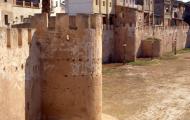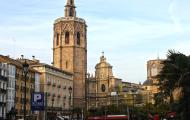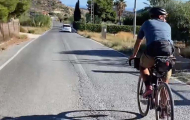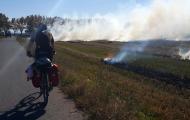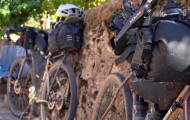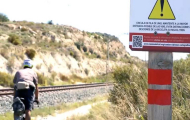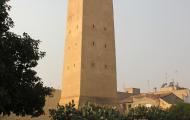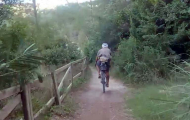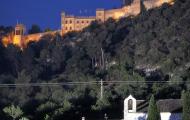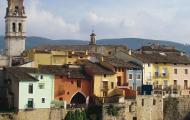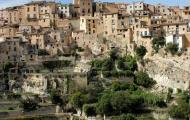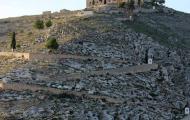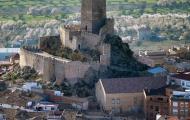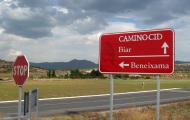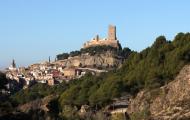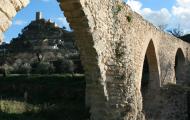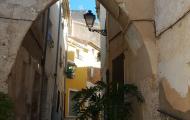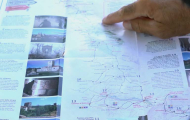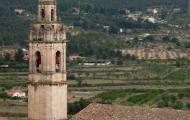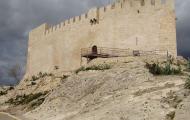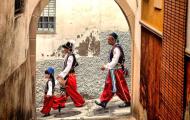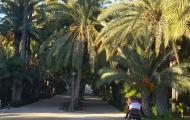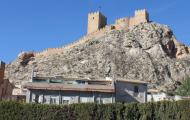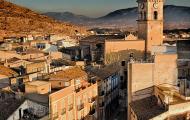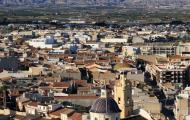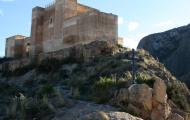Defending the South route by Gravel Bike
VALENCIA - ALICANTE
Defending the South route by Gravel Bike: A historical and literary route along the inland defence line near the Mediterranean
Set off on your journey to the last frontier of El Cid: Orihuela. Ideal in autumn, winter or spring: take your bike and cycle through a diverse and surprising territory. The provinces of Valencia and Alicante from the inside: if you haven't been, you don't know what you're missing.
- Route: From Valencia to Orihuela (Alicante).
- Provinces: Valencia and Alicante.
- Kilometres: 253 km approx.
- Recommended days: 3 days (84 km / day approx.)

| TECHNICAL DATA | ||
| Distance: 253 km | Accumulated ascent: 2,500 m | Physical difficulty: Medium |
| Estimated time: 3/4 days | Accumulated descent: 2,500 m | Technical difficulty: Low |
| This is a route designed for gravel bikes and is 100% cyclable, following rural roads with a good surface, comfortable tracks and lonely roads. The route does not offer any significant slopes or significant complications, so you will be able to move at a good pace and enjoy a wide variety of landscapes. | ||
Information you can download on this page
- PDF gravel guide (contains detailed maps)
- The list of accommodation.
- The list of tourist offices.
- The tourist brochure ( which you can request at any of the tourist offices along the route).
- The tracks of the route in gpx, kmz and trkformat .
Remember that in the Tourist Offices of the Camino del Cid you can get more information about each route free of charge: including brochures and the safe-conduct.
Download our travel app free of charge
We recommend you download our mobile travel app, available on iOS and Android. The app contains all our routes, you'll never get lost and you'll find information on 4,500 geo-referenced points (Cidian enclaves, places to see, accommodation, pass stamping points, etc.).
The app is free, updated daily and does not require registration. It also works in environments without coverage, so during installation and when you first turn it on, depending on your connection, it may take a few minutes to get it up and running, so be patient, it's worth it!

The Plot: a historical and literary route along the inland defence line
Unlike the previous routes, along the southern defence line – La Defensa del Sur – history takes precedence over literature. The author of The Poem of the Cid was unable to come up with arguments strong enough to merge into a single plot the two periods of exile to which, according to history, El Cid was condemned by Alphonse VI. The first was in Castile, in 1081, and the second, far harsher and more significant, in 1088, during the time El Cid spent in Alicante. This route retraces this historic episode, together with a number of others related to the threat from the south of the Almoravid dynasty.
Great is the rejoicing there/ when mio Cid took Valencia and entered the city / Men who had been on foot made it into the city on horseback / and as for the gold and silver, who could count it? The conquest of Valencia by El Cid was the culmination of a dream yet also the origin of serious concerns surrounding the need to defend the city, which would withstand the Almoravid onslaught until 1102, the year when Jimena – El Cid had died three years previously – left the city.
According to the Poem, El Cid finally managed to enter Valencia after a long and drawn-out siege. The King of Seville attempted to regain the city but was defeated in a battle fought out in the Huerta de Valencia region. It is then that El Cid was pardoned by Alphonse VI; his wife and daughters travelled to Valencia and El Cid would show them the extent of his domains from the fortress tower. The Almoravid King Yusuf would later march on the city with 50,000, but they were also repelled. Following this victory, El Cid married his daughters to the Infantes of Carrión. Two years later, King Bucar laid siege to Valencia, setting up a camp with 50,000 tents. He was defeated and slain by El Cid, who seized his sword, known as Tizona, worth a thousand gold coins. Finally, after recovering his honour and being proclaimed a great lord and warrior, El Cid died in Valencia.
Although this is the story narrated in the Poem, history has a very different tale to tell. Generally-speaking, most of the towns in the south of Valencia sided with the powerful Almoravids, who had set up their military base in Murcia. There is historical evidence that during the siege of Valencia, an Almoravid army camped in Almussafes but were forced to retreat following torrential flooding. In 1093 El Cid attacked the city of Alzira, which had refused to support him. He ordered the harvesting of the local crops which were then taken to his general headquarters in El Puig and in 1097 a contingent of his men were defeated in Alzira by an Almoravid expedition.
During the later years of Rodrigo’s life, even Xàtiva, which had initially yielded to the might and power of El Cid, became the spearhead for the Almoravid offensive against Valencia. Indeed, the Poem of The Cid relates that it was there that the Moorish King of Seville sought shelter there whilst fleeing from Rodrigo.
The second reason for this route is historical, and starts some 25 km from Xàtiva, in Ontinyent. In November 1088 El Cid travelled from Xàtiva to Ontinyent to await the arrival of King Alphonse VI, who was on his way to assist Aledo. The king asked Rodrigo to wait for him in Villena, but he chose Ontinyent instead because there he could be sure of sufficient provisions for his men. The meeting between the two forces never took place, and El Cid set up camp in Elche where he spent the Christmas period. It was there that he heard the news that Alphonse VI had declared him a traitor, once again casting him into exile. In the midst of enemy territory he vowed never again to serve any master, and to act only in accordance with his own free will.
The route ends in Orihuela. The connection with Orihuela dates back to 1090. After defeating the Catalonian Count Berenguer Ramón II at the Battle of Tévar, El Cid set up a vast protectorate of the Moorish kingdom of Al Hayib, which included the territories of Lerida, Tortosa and Denia. According to Ben Alcamo, by 1091 this protectorate extended from Tortosa to Orihuela.
The Journey
The Defence of the South offers strong contrasts: from highly urbanised stretches where farm tracks and green asphalt roads prevail to paths in the more mountainous areas. After leaving Valencia and its surroundings, the traveller will come across two of the great icons of this territory: La Albufera and the Valencian market gardens.
The Albufera is a shallow coastal lagoon - an average of one metre deep - surrounded by rice fields and closed to the sea by a sand bar created by the sea currents. It has been exploited by man since ancient times and today it is home to a good number of animal and plant species: from water birds to endangered fish, such as the fartet and the samarugo.
The second "encounter" is the Valencian market garden: an unprecedented economic, social and natural fact that has its roots in history. The Valencian orchard and gardens, so highly valued by the Arabs, were sung in the 11th century by the poet Ibn Jafaya, a native of Alzira. The walls of Alzira, of Islamic origin, evoke this memory. Alzira is one of the eight towns on this route that have been declared historical and/or artistic sites. Next is Xàtiva, which boasts an enviable historical and artistic heritage, headed by its castle, one of the most impressive on the Camino del Cid.
From Ontinyent we start the ascent to Bocairent. The ascent is along 9 km of road between spectacular cut-offs: although this road is frequented by cyclists, it lacks a hard shoulder in many sections and traffic is heavy, which means we have to take extreme precautions. Before starting the ascent, take it easy and if the weather is good, take a natural bath in the Pou Clar. The final reward, Bocairent, will not disappoint you.
The Way of El Cid enters the province of Alicante through Banyeres de Mariola. Its castle is the first of a defensive line of Almohad origin that continues through Biar, Villena, Sax, and Petrer until it reaches Elche, with a very important heritage of medieval origin among which its Palm Grove, declared a World Heritage Site, stands out. From Elche we continue descending to Bajo Vinalopó. The aridity of the landscape contrasts with the fertile cultivated fields and the widespread presence of palm groves: a densely populated territory that symbolically ends at the southern end of El Cid's sphere of influence: the monumental Orihuela.
Culinary Delights
Although rice is the hallmark of Valencia’s cuisine, with a wide range of varieties and a host of different dishes prepared in multiple ways (paella, a banda - cooked in stock -, creamed, in squid ink, in desserts, etc.), this is also a land characterised by its gastronomic intensity and diversity. For instance, Valencia’s vegetable and fruit orchards have been renowned since the days of the Moors, resulting in a long list of mouth-watering dishes, such as pericana – an intensely flavoured sauce made from poor cod, olive oil and sun-dried peppers – and fish, freshly caught off the coast. After all, this is the Mediterranean.
Travellers will also have the chance to taste a different kind of cuisine, characteristic of this land, such as the guisos de los marjales or eel stews, or the puchero valenciano which, unlike the stews and casseroles of Castile, is lighter and contains less fat. The inland and mountain areas of Alicante are the perfect choice for enjoying a dish traditionally eaten by shepherds and that when properly prepared is absolutely delicious: Alicante gazpacho, made with meat, normally hare or partridge seasoned with local herbs and served with flour flat bread.
When it comes to sweets and desserts, and without forgetting the famous citrus fruits and horchatas – tiger nut milk drinks – it must be remembered that these lands are home to turrón nougat. Alicante’s nougat is famed throughout the world, but both Valencia and Alicante produce delicious almond nougats made from traditional recipes.
Carreteras singulares
The term Carreteras Singulares or ‘Singular Roads’ is used to refer to those stretches of the Way of El Cid of particular importance for cycle tourism or of environmental, historical or artistic value. This route includes the following Singular Roads.
- CV 81 entre Ontinyent y Bocairent (7 km). Valencia
This road links two unique towns on the Camino del Cid in the province of Valencia, both with important historical and artistic sites: Ontinyent and Bocairent, and it does so after leaving a natural bathing area by a road that climbs steadily upwards through the Sierra de Mariola, a valuable and rich ecosystem with abundant mixed gall oak forests. This road is different from the others: its uphill profile is steep and demanding, especially if you are carrying panniers; it also has a lot of traffic, and although the road surface is good, the hard shoulder disappears in some sections. Despite all this, it is, curiously enough, a road frequented by cyclists, so get your strength back before you start the ascent, and do it with caution!
Signposting
We have designed a route that is 100% suitable for gravel bikes, following rural roads with a good surface, comfortable tracks, asphalted roads and lonely roads. There is no signposting of the gravel route as such, but as it largely coincides with the MTB and hiking routes, you should pay attention to the signposting on these sections.
We recommend you download the track or the App, and before starting your journey, checkthe Route Alerts box in our map viewer, which shows you the most important incidents that you may encounter on the route: high vegetation, interrupted crossings, road works, fallen or missing signs and any other obstacle that you need to be warned of.
Climatology
In the east of Valencia we find one of the most benign climates on the peninsula: the Mediterranean climate, with dry and warm summers, mild winters and an autumn in which the so-called gota fría (cold front) is common, causing heavy rainfall in the form of torrential storms.
Average rainfall in Valencia is over 450 mm and is concentrated in just 44 days per year, offering a very high average number of sunny days. However, as the Camino enters the interior and ascends in altitude, we will find some points where the climate approaches the continental climate of the plateau, with harsh winters and dry summers, with frosts that can last until spring, and even sporadic snow in winter.
Tips and recommendations
Some stretches of this road have very little traffic, whilst others are extremely busy. Take great care: over confidence causes distractions that can have serious consequences. We recommend using a rear view mirror for bicycles: they are detachable and generally speaking are extremely useful.
Length of the stages: it is best for each one to decide their own stages according to their strengths and personal preferences. Some people place the emphasis on doing exercise, others on the cultural side of the route and others on the simple pleasure of taking in the countryside and locations. The stages we suggest are a combination of all three and have been designed for average tourists cycling under stable weather conditions to enjoy the route without too much stress.
Travel safely and unhurriedly: take the tracks and route guide with you.
Water and spares. It is very important to take water with you. In most of the villages, there are drinking fountains: remember to refill your water bottles before setting off again. The same applies for spare parts: remember to take a repair kit with you and the more complete it is, the greater your peace of mind will be.
Book your accommodation in advance. You are about to travel through one of the areas with the lowest population density in Europe. Some villages are very small and have limited infrastructures. Book your accommodation at the end of the stage in advance and if you change where you plan to finish the route, check that there is accommodation available there.
Check our cartographic viewer: the Alerts on Route shows you the most important incidents you can find on the way: tall vegetation, interrupted steps, road works, fallen or missing signs and any other obstacle from which you need to be warned about.
Don't forget your helmet: it is compulsory for adults to wear helmets on roads outside cities and for under 16s it is compulsory at all times.
Get your Letter of safe conduct. The Letter of Safe Conduct is a personalised 'passport' you can have stamped at many towns and villages on the Way of El Cid.
Your literary guide. You might think it's unnecessary weight, but for many it is essential: don't forget to take with you a copy of the Poem of The Cid; you will be able to recreate some of its passages on site.
Rev. ALC: 21.05.2025




